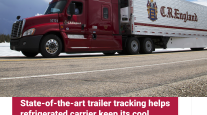Opinion: Four Disruptive Technology Trends in Trucking
When it comes to the trucking industry, we deal with a pace of change that has been constant for years: changing fuel costs, increased regulations, driver shortages, etc. These issues definitely have an effect on industry revenue; however, they are not technically disruptive. But now four distinct trends are currently disrupting the trucking industry. It’s essential to recognize the advantages these trends offer, realize the challenges they pose and identify how to deal with them.

Kresge
1) Telematics: This integration information and communication technology enables vehicles to send, receive and store information related to that vehicle via telecommunication devices.
• Advantages: Full visibility into every aspect of your vehicle’s situation (location, detention time, equipment issues) provides the data necessary to optimize your entire fleet’s performance.
• Challenges: New technologies add extra cost to the truck, which can be difficult for smaller fleets or owner-operators to absorb. For all sizes of fleets, consideration must be given to the time it takes to install equipment and train drivers and technicians.
• Dealing with challenges: Fleet managers need to look at telematics as more than just a way to be compliant with new and potential regulations. The data provided also give information that can be used to make more strategic decisions for fleet operations and performance.
2) Uberization: Capitalizing on the concept of the “gig” econ-omy represented by Uber and Lyft, trucking now has apps to locate empty truck space. The concept is not new; it’s just a new way to approach freight consolidation.
• Advantages: For the carrier, this is a way to monetize empty miles. For shippers, it’s a way to potentially reduce costs and also guarantee freight space for sudden surges in orders.
• Challenges: It’s all about trust. Shippers are being asked to put their load in the hands of a potentially unfamiliar carrier or driver. What if your goods are perishable or you need to make a specific delivery window? What happens if the vehicle isn’t compliant with regulations? A certain amount of risk is part of this trend.
• Dealing with challenges: Shippers must perform due diligence to ensure satisfactory service by asking the right questions. If you can get a contracted rate that is guaranteed, regardless of in- creases in fuel costs or detention time, then you can realize savings in both time and money.
3) Last-Mile Delivery: Despite Wal-Mart’s use of employees to deliver goods ordered online to customers located on the employee’s route home, as well as Amazon’s drone delivery initiative, businesses are trying to find more traditional ways to get their goods to customers faster and at less expense.
• Advantages: Closer proximity to the customer means faster delivery, which makes the customer happy. That also means savings in time and fuel, reduced chances of delivery delays due to weather or construction, and a range of other issues that can plague long-range delivery.
• Challenges: Some companies have decided to build distribution centers in more centralized locations, so that’s a cost that has to be considered. Another cost factor to consider is whether or not you’re able to guarantee that there is enough freight to optimize the use of a vehicle. Proximity won’t matter if a truck is partially empty.
• Dealing with challenges: Shippers need to do their due diligence to decide what works best for their specific business. Working with customers on cross-docking is a win-win-win for drivers, carriers and shippers. Over-the-road drivers will deliver the freight to a common location, leave that load in a specified drop-off point and return back to their origin — no issues with traditional unloading at docks, no detention issues. That extra time is something over-the-road drivers greatly appreciate. For carriers, that speed of return gives them the opportunity to do more business as load space may be available days earlier than if they had to follow the traditional unloading practice. For shippers, they can consolidate product that comes from different locations into one full shipment.
4) Driverless Trucks: Views vary on when autonomous trucks will become a reality on the road, but many believe it will happen within this decade. However, autonomous trucks will not be “human-less” trucks. You’ll still need someone on board for the near and distant future to guarantee that unforeseen issues can be dealt with.
• Advantages: Proponents believe that autonomous vehicles — cars and trucks — will be much safer than their human-driven counterparts. Plus, the technology will enable safe platooning, which ultimately can result in significant fuel savings.
• Challenges: These vehicles will be quite costly and potentially too expensive for smaller companies. There’s also the fear that the technology could fail, and an 80,000-pound truck in an accident can cause a lot more damage than an accident involving a passenger car. We’re assured by the proponents that the technology is safer than a human driver, but situations can still arise that need the knowledge and expertise of a professional, experienced driver.
• Dealing with challenges: Don’t wait for autonomous trucks to take advantage of today’s safety technology. From parking assist to lane departure warnings to technology that’s able to monitor the health of the driver, technology that will ensure greater safety and reduce risk is available. Do a cost-benefit analysis to ascertain the ROI on installing such technology.
The bottom line is this: Whether you like it or not, fighting these advances is futile. The future is now.
Kresge is vice president of dedicated services and logistics at NationaLease. The Downers Grove, Ill.-based company is one of the largest full-service truck leasing organizations in North America.




